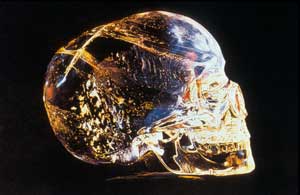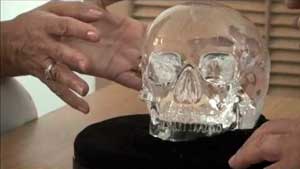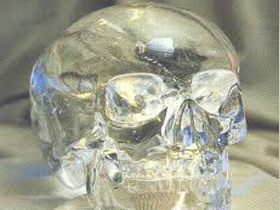
On 1 January, 1924, Canadian Anna Mitchell Hedges discovered a crystal skull beneath an alter in a pyramid temple in the lost Mayan city of Lubaantun (meaning the city of the fallen stones in the Mayan language).
The skull was the same size as a genuine human skull and consists entirely of transparent quartz. The anatomically completely accurate skull, with its separate mobile lower jaw was carved from one whole piece of quartz crystal.
Anna Mitchell Hedges wished to discover who made the skull, and when, and gave it to the world-renowned company Hewlett-Packard for testing. Since the crystal contained no carbon, scientists were unable to perform radio-carbon dating, but used different techniques to try to establish when the skull had been made, and using which methods.

1. The skull was made from quartz crystal, used in present-day electronic industry:A team of scientists revealed that the skull has been made out of a form of quartz known as piezoelectric silicon dioxide, used in the current telecommunications sector and with a higher memory capacity than other. Latest micro-processors are made from the same substance. Even more striking, however, is the fact that this form of crystal was only discovered in the 19th century.
2. The crystal skull has the ability to produce its own electricity:This crystal, piezoelectric silicon dioxide, is both negative and positively polarized. This means that, as with batteries, it is able to produce its own electricity.
3. The skull was produced from a single block of crystal:Scientists used a series of polarized test lights to establish that the skull and the lower jaw were made from the same block of crystal rock. Considering that quartz crystal is softer and more brittle than diamond, the fact the skull was carved from a single piece of crystal, which is almost impossible, amazed scientists.

4. No signs of any tools were discovered on the skull:The scientists decided to examine the skull under a microscope to determine whether any tools had been used in its manufacture. They were amazed to find no signs that modern automatic equipment or mechanical tools had been used in the crystal skull’s manufacture. Crystal rock is very brittle and friable, and it would have fallen apart had any tools been used during the carving. Because modern manufacturing tools would immediately break it because of their heat and vibrations. Hewlett-Packard concluded that it was impossible to produce such a delicate and fine component as the lower jaw, from a single piece of crystal, even using modern diamond-tipped electrical equipment, without shattering it. This led one of the team of scientists to say, “this skull shouldn’t even exist” and resulted in a number of other observers also speculating that the skull might not be human in origin. Following these tests, the crystal skull was interpreted as having been made by hand.

5. Had the crystal skull been carved by hand, it would have taken around 300 years, and several generations to have its present shape: The scientists calculated that it would have taken several generations to carve the skull, using no tools apart from rubbing at it with a piece of diamond. According to the Hewlett-Packard report, it would have taken some 300 years to shape the skull by abrading it by hand.
6. There are no cracks in the crystal skull, despite its being carved in total violation of the laws of physics: Present-day crystals are carved around their axes. Because crystals have a molecular symmetry. In order not to break the crystal, it has to be cut in line with that natural structure, its molecular symmetry, in other words. Even if lasers of high-tech cutting techniques are used, crystals will still shatter if not cut along their natural axes. But even though this crystal skull was cut in a manner totally independent of its axis, no fracturing or cracking arose, in complete violation of the laws of physics.
7. Scientists were astonished by the crystal skull’s optical design:As a result of the Hewlett-Packard tests, scientists realized that the skull had interesting optical properties. Light applied from beneath the skull should normally be refracted in all directions, but in this skull it forms a channel focusing on the eye sockets and emerging from these.
8. The prism inside the crystal skull concentrates an image of the area in the eyes: There is a kind of prism in the lower, rear part of the skull. Light striking the eye sockets is reflected from here. Therefore, if you look directly into the sockets you see that the whole room is reflected inside the eyes of the crystal skull.
Structures that present-day technology still struggles to account for, such as Stonehenge in England, constructed 8,000 years ago, the Egyptian pyramids, the T-shaped animal motifs carved 11,000 years ago on Gobekli Tepe in Urfa, Turkey and the 10-ton Sun gate carved from a single rock, prove that people in ancient times were not primitive and lacking any comprehension of art, science and technology, as is sometimes claimed. Evolutionists have attempted to apply the same perverse, evolutionary logic they sought to apply to such branches of science as biology, paleontology, zoology, entomology and botany to archeology, as well. But the historical artifacts that emerge into the light of day scientifically refute the evolutionist claim that ape-like beings gradually developed into modern man.
Sources:
- Sacred Hoop Magazine, No. 21, Summer 1998
- Chris Morton and Ceri Louise Thomas, The Mystery of the Crystal Skulls, Bear & Company/Inner Traditions (in America and Canada), Element/Harper Collins (in Great Britain)


